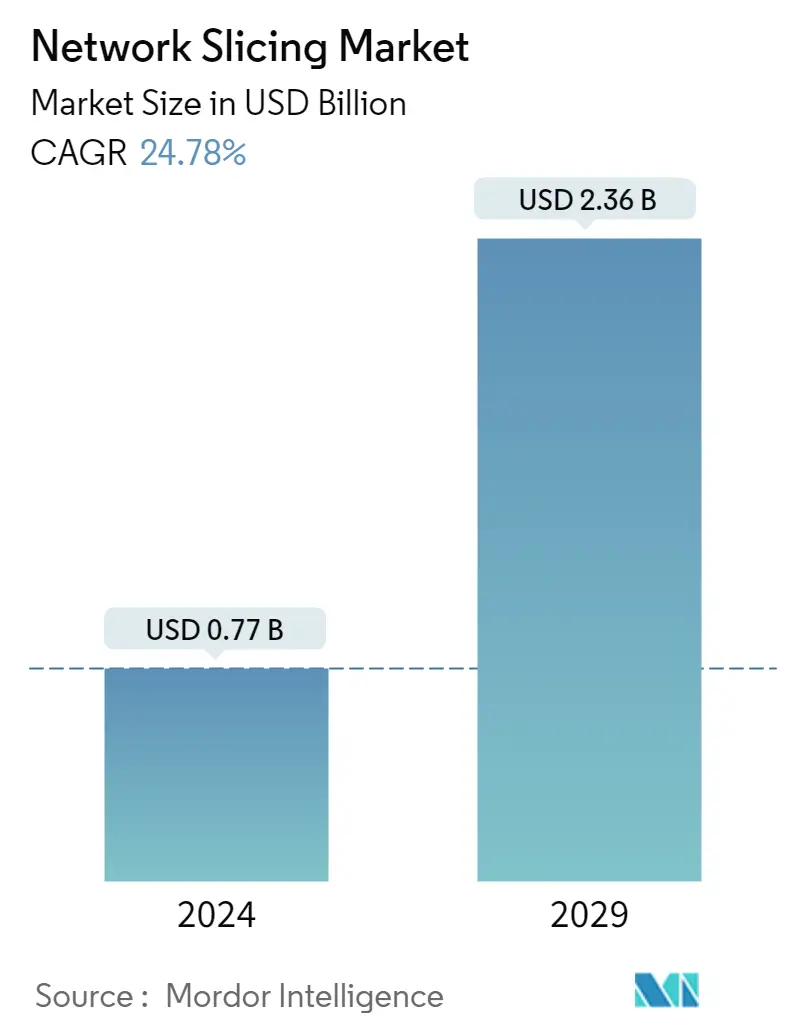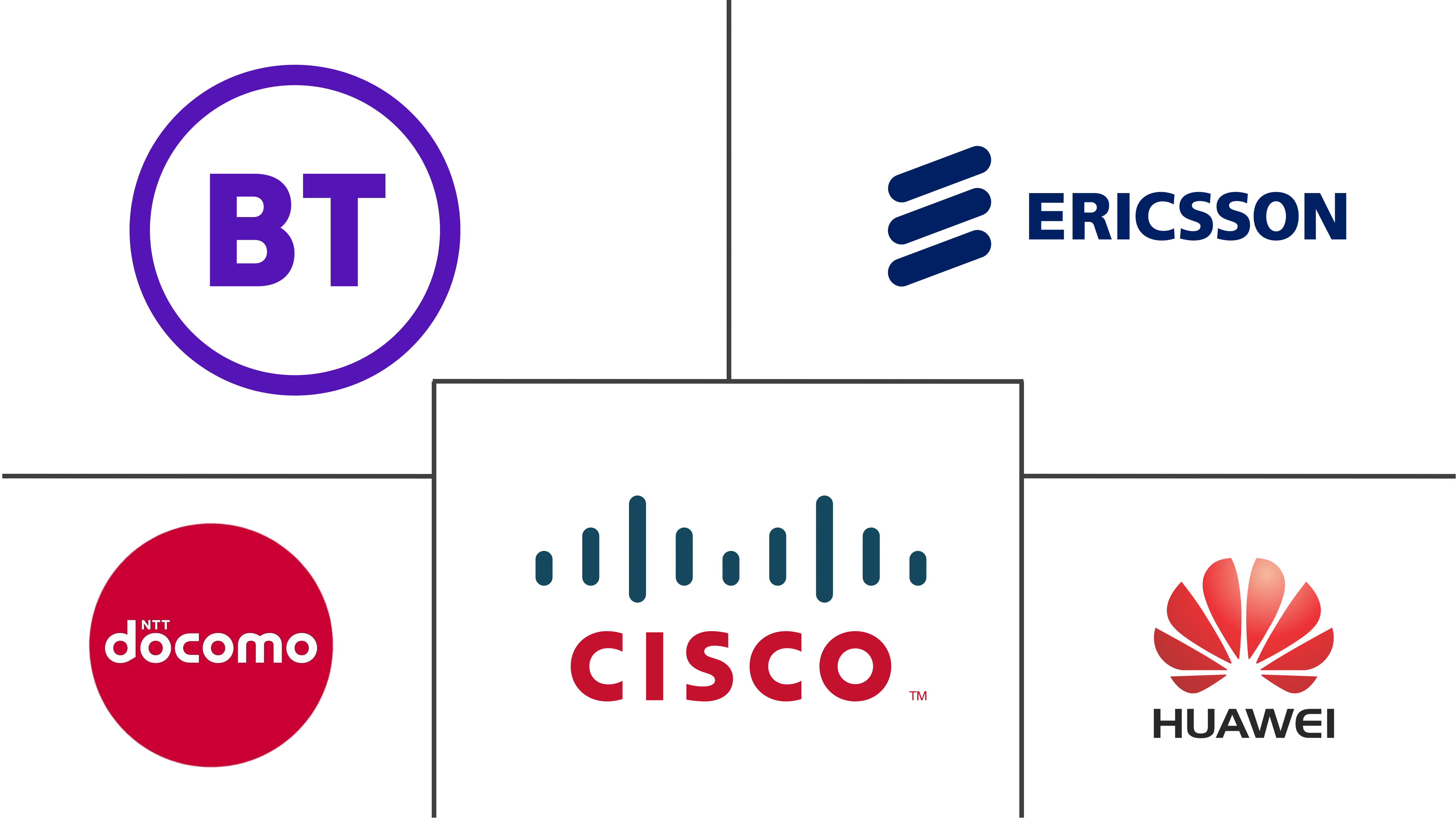Market Size of Network Slicing Industry

| Study Period | 2019 - 2029 |
| Market Size (2024) | USD 0.77 Billion |
| Market Size (2029) | USD 2.36 Billion |
| CAGR (2024 - 2029) | 24.78 % |
| Fastest Growing Market | Asia Pacific |
| Largest Market | North America |
Major Players
*Disclaimer: Major Players sorted in no particular order |
Network Slicing Market Analysis
The Network Slicing Market size is estimated at USD 0.77 billion in 2024, and is expected to reach USD 2.36 billion by 2029, growing at a CAGR of 24.78% during the forecast period (2024-2029).
According to GSMA, network slicing, in combination with other enablers and capabilities, will aid operators in addressing a revenue opportunity worth USD 300 billion by 2025.
- 5G networks, in combination with network slicing, allow business customers to enjoy connectivity and data processing that are tailored to the specific business requirements and adhere to a Service Level Agreement (SLA) as agreed with the mobile operator. Customizable network capabilities include data speed, latency, quality, security, and services. Thus as the demand for high-speed network coverage is progressing, it will open new avenues for the market.
- However, 5G is struggling to keep pace in emerging economies due to low bandwidth and a lack of infrastructure. For instance, India's smart city initiative launched two years ago has struggled to make significant progress. Beyond the numerous local regulatory and structural challenges, there needs to be more spectrum or even the right spectrum bands available for the smart city vision to be realized.
- Various industries are being transformed by the widespread use of IoT and ongoing improvements in Machine-to-Machine (M2M) communication networks, which are connecting all different kinds of equipment, systems, and services. One of the many use cases that network slicing-enabled 5G will allow is the Internet of Things, which would provide communication between a significant number of sensors and linked devices. High-power, low-latency applications (such as mobile video surveillance) and low-power, low-latency, long-range IoT applications are two categories of IoT application requirements (smart cities and smart factories). To meet these needs for growing IoT applications, which are characterized as huge machine-type communication and mission-critical applications, the evolution of 5G Technology is anticipated to pick up speed.
- However, Network slicing security, which may cause significant losses for enterprises and service providers, is a major worry for CIOs. SDN, NFV, and cloud-native architecture have all been used to construct the new network infrastructure. Network functions are spread across local, regional, and central data centers and are decoupled from supporting infrastructure. The vast majority of network services in a 5G network based on the cloud are implemented through public and private cloud infrastructure.
- With the aid of expanding mobile networking and remote access services in a number of industries, including retail, telecom, IT, and healthcare, the pandemic has considerably driven demand for broadband services. Additionally, as businesses all around the world have begun to reopen, communications service providers are refocusing on 5G rollouts and stepping up their network-slicing efforts. Additionally, COVID-19 has increased interest in 5G use cases, including robotics, telemedicine, remote education, and remote offices, all contributing to the network-slicing market.
Network Slicing Industry Segmentation
When utilizing network slicing, business customers have access to highly customized networks tailored to their specific requirements in a cost-effective, timely, and efficient way which can be governed by a service level agreement. The consumer industry, automotive, government, utilities, and logistics are some of the sectors with high potential for the application of network slicing.
The Network Slicing Market is segmented by Application (Real-Time Surveillance, Network Function Virtualization), Service (Professional, Managed), End-user Industry (Healthcare, Automotive, Power & Energy, Aviation, Media & Entertainment), and Geography.
The market sizes and forecasts are provided in terms of value (USD million) for all the above segments.
| By Application | |
| Real-Time Surveillance | |
| Network Function Virtualization |
| By Service | |
| Professional | |
| Managed |
| By End-user Industry | |
| Healthcare | |
| Automotive | |
| Power & Energy | |
| Aviation | |
| Media & Entertainment |
| Geography | |
| North America | |
| Europe | |
| Asia-Pacific | |
| Latin America | |
| Middle East & Africa |
Network Slicing Market Size Summary
The network slicing market is poised for significant growth, driven by the increasing demand for customized connectivity solutions in various industries. As 5G technology continues to evolve, network slicing enables businesses to tailor their network capabilities—such as data speed, latency, and security—according to specific requirements and service level agreements. This flexibility is particularly beneficial for sectors like healthcare, where low-latency and high-bandwidth connections are crucial for applications such as remote surgeries and real-time medical device monitoring. The integration of IoT and advancements in Machine-to-Machine communication further amplify the potential of network slicing, facilitating the connectivity of numerous sensors and devices across smart cities and factories. However, challenges such as security concerns and infrastructure limitations in emerging economies like India and China pose hurdles to widespread adoption.
The Asia-Pacific region is expected to experience rapid expansion in the network slicing market, supported by robust technological infrastructure and government initiatives promoting industry and technology advancement. The region's focus on cloud-based solutions, IoT, and big data analytics is driving the adoption of network slicing across various sectors. As mobile operators in APAC invest significantly in 5G deployments, the region is set to become a major hub for connected devices and innovative consumer services. The pandemic has accelerated the demand for broadband services, prompting telecom companies to intensify their 5G rollouts and network-slicing efforts. Key players in the market, including Ericsson, Huawei, Cisco, and BT Group, are collaborating to enhance network slice management solutions, ensuring the availability, latency, and security required for seamless connectivity.
Network Slicing Market Size - Table of Contents
-
1. MARKET DYNAMICS
-
1.1 Market Overview
-
1.2 Introduction to Market Drivers and Restraints
-
1.3 Market Drivers
-
1.3.1 Increasing Demand For High-speed And Large Network Coverage is Major Driving Force
-
-
1.4 Market Restraints
-
1.4.1 Low 5G Penetration in Emerging Economies is Challenging the Market Growth
-
-
1.5 Industry Attractiveness - Porter's Five Force Analysis
-
1.5.1 Threat of New Entrants
-
1.5.2 Bargaining Power of Buyers/Consumers
-
1.5.3 Bargaining Power of Suppliers
-
1.5.4 Threat of Substitute Products
-
1.5.5 Intensity of Competitive Rivalry
-
-
-
2. MARKET SEGMENTATION
-
2.1 By Application
-
2.1.1 Real-Time Surveillance
-
2.1.2 Network Function Virtualization
-
-
2.2 By Service
-
2.2.1 Professional
-
2.2.2 Managed
-
-
2.3 By End-user Industry
-
2.3.1 Healthcare
-
2.3.2 Automotive
-
2.3.3 Power & Energy
-
2.3.4 Aviation
-
2.3.5 Media & Entertainment
-
-
2.4 Geography
-
2.4.1 North America
-
2.4.2 Europe
-
2.4.3 Asia-Pacific
-
2.4.4 Latin America
-
2.4.5 Middle East & Africa
-
-
Network Slicing Market Size FAQs
How big is the Network Slicing Market?
The Network Slicing Market size is expected to reach USD 0.77 billion in 2024 and grow at a CAGR of 24.78% to reach USD 2.36 billion by 2029.
What is the current Network Slicing Market size?
In 2024, the Network Slicing Market size is expected to reach USD 0.77 billion.

